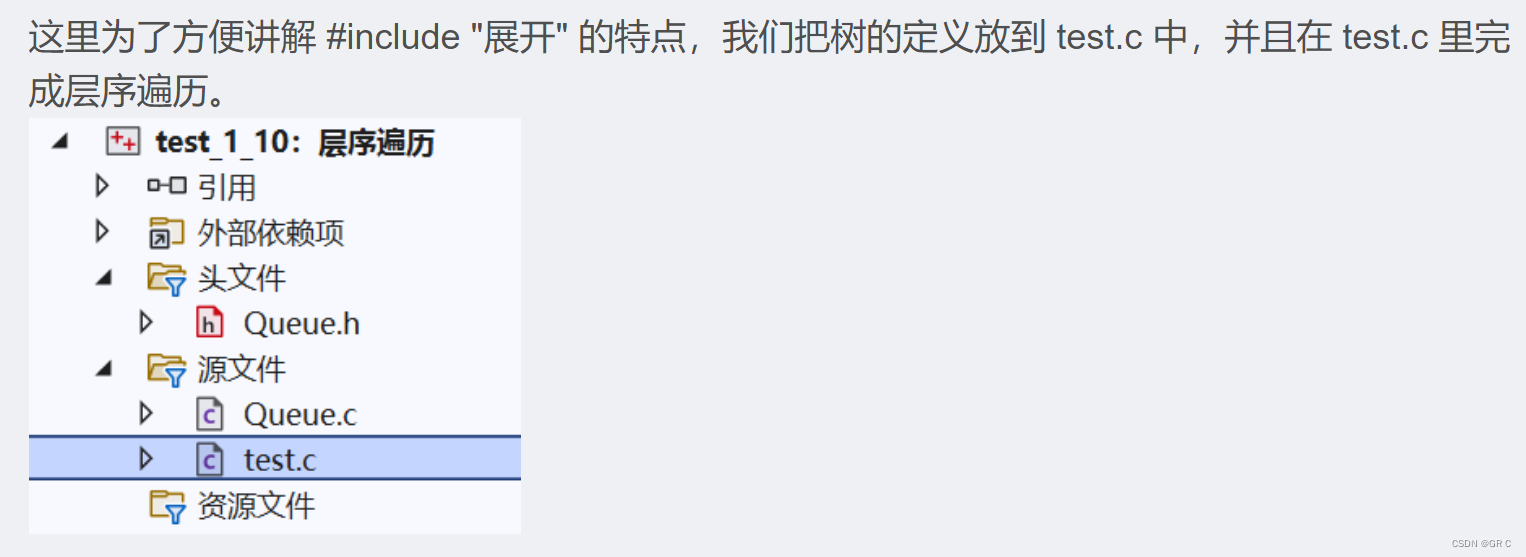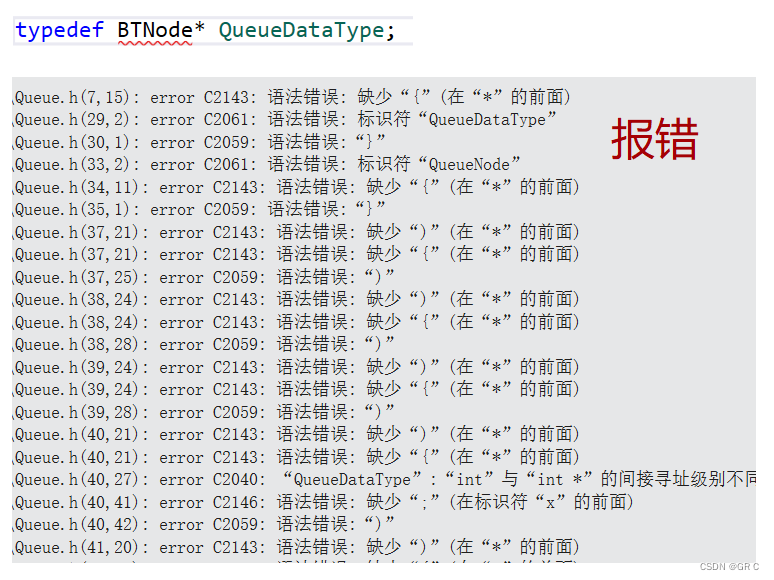比特数据结构与算法(第四章_收尾)二叉树的层序遍历和一道OJ
1.层序遍历
前面我们在二叉树的遍历里提到过层序遍历(Level Traversal)
链接:比特数据结构与算法(第四章_下)二叉树的遍历_GR C的博客-CSDN博客
设二叉树的根节点所在的层数为1的情况下,从二叉树的根节点出发,首先访问第1层的树根节点,
然后再从左到右访问第2层上的节点。接着是第3层的节点……以此类推,

上面这棵树的层序遍历就是3 9 20 15 7
该如何实现层序遍历呢?
我们可以之前用以前写的队列来实现
链接:比特数据结构与算法(第三章_下)队列的概念和实现(力扣:225+232+622)_GR C的博客-CSDN博客
Queue.h:
#pragma once#include
#include
#include
#include typedef int QueueDataType; //队列类型typedef struct QueueNode
{struct QueueNode* next; //指向下一个节点QueueDataType data; //数据
} QueueNode;typedef struct Queue//如果不设置成结构体就需要传二级指针,还要传两个参数
{QueueNode* pHead;QueueNode* pTail;
} Queue;void QueueInit(Queue* pQ);//初始化队列
void QueueDestroy(Queue* pQ);//销毁队列
bool QueueEmpty(Queue* pQ);//判断队列是否为空
void QueuePush(Queue* pQ, QueueDataType x);//入队
void QueuePop(Queue* pQ);//出队
QueueDataType QueueFront(Queue* pQ);//返回队头数据
QueueDataType QueueBack(Queue* pQ);//返回队尾数据
int QueueSize(Queue* pQ);//返回队列大小 Queue.c:
#include "Queue.h"void QueueInit(Queue* pQ)
{assert(pQ);pQ->pHead = pQ->pTail = NULL;
}void QueueDestroy(Queue* pQ)
{assert(pQ); QueueNode* cur = pQ->pHead;while (cur != NULL) {QueueNode* curNext = cur->next; //防止释放cur后找不到其下一个节点free(cur); cur = curNext; }pQ->pHead = pQ->pTail = NULL;
}bool QueueEmpty(Queue* pQ)
{assert(pQ); return pQ->pHead == NULL;//如果成立则为True,不成立则为False
}//入队:队尾入数据,队头出(删)数据。如果是第一个入队的(队列为空)则既要当头又当尾
void QueuePush(Queue* pQ, QueueDataType x)
{assert(pQ);QueueNode* new_node = (QueueNode*)malloc(sizeof(QueueNode));if (new_node == NULL){printf("malloc failed!\n");exit(-1);}new_node->data = x; //待插入的数据new_node->next = NULL; //新的数据指向空if (pQ->pHead == NULL)//情况1: 队列为空{ pQ->pHead = pQ->pTail = new_node;}else //情况2: 队列不为空 队尾入数据{ pQ->pTail->next = new_node; //在现有尾的后一个节点放置new_nodepQ->pTail = new_node; //更新pTail,使它指向新的尾}
}void QueuePop(Queue* pQ) // 出队:队尾入数据,队头出(删)数据
{assert(pQ); assert(!QueueEmpty(pQ)); QueueNode* headNext = pQ->pHead->next; //队头出数据,防止释放pHead后找不到其下一个节点free(pQ->pHead);pQ->pHead = headNext; //更新头 if (pQ->pHead == NULL)//删完之后 pHead == NULL 了 pTail 还是野指针{pQ->pTail = NULL;//处理一下尾指针,将尾指针置空}
}QueueDataType QueueFront(Queue* pQ) //返回队头数据
{assert(pQ); assert(!QueueEmpty(pQ)); return pQ->pHead->data;
}QueueDataType QueueBack(Queue* pQ) //返回队尾数据
{assert(pQ);assert(!QueueEmpty(pQ));return pQ->pTail->data;
}int QueueSize(Queue* pQ) //返回队列大小
{assert(pQ);int count = 0;QueueNode* cur = pQ->pHead;while (cur != NULL) {count++;cur = cur->next;}return count;
}
test.c
#include "Queue.h"typedef int BTDataType;typedef struct BinaryTreeNode
{struct BinaryTreeNode* left; // 记录左节点struct BinaryTreeNode* right; // 记录右节点BTDataType data; // 存储数据
} BTNode;//创建新节点
BTNode* CreateNode(BTDataType x)
{BTNode* new_node = (BTNode*)malloc(sizeof(BTNode));if (new_node == NULL){printf("malloc failed!\n");exit(-1);}new_node->data = x;new_node->left = new_node->right = NULL;return new_node;
}由于是我们的数据类型是 BTNode,我们需要修改一下 Queue.h 的 QueueDataType,我们之前一直强调的 typedef 的好处,这里就显现出来了。我们只需要把 int 改成 BTNode 就可以了,而不需要改很多地方。
新Queue.h:
#pragma once#include
#include
#include
#include typedef BTNode* QueueDataType; //队列类型typedef struct QueueNode
{struct QueueNode* next; //指向下一个节点QueueDataType data; //数据
} QueueNode;typedef struct Queue//如果不设置成结构体就需要传二级指针,还要传两个参数
{QueueNode* pHead;QueueNode* pTail;
} Queue;void QueueInit(Queue* pQ);//初始化队列
void QueueDestroy(Queue* pQ);//销毁队列
bool QueueEmpty(Queue* pQ);//判断队列是否为空
void QueuePush(Queue* pQ, QueueDataType x);//入队
void QueuePop(Queue* pQ);//出队
QueueDataType QueueFront(Queue* pQ);//返回队头数据
QueueDataType QueueBack(Queue* pQ);//返回队尾数据
int QueueSize(Queue* pQ);//返回队列大小 
它说,缺少 " { " ,这明显是胡说八道的,咱编译器也没有那么智能,毕竟是也不是VS2077。
这里产生问题的原因是什么呢?
编译器原则:编译器认识 int,因为 int 是一个内置类型。但是 BTNode* 编译器并不认识,就需要 "往上面" 去找这个类型。这里显然往上找,是找不到它的定义的,所以编译器会报错。

如果你要用这个类型,你就需要先定义这个类型。test.c文件中 #include "Queue.h" ,相当于把这里的代码拷贝过去了。这时,由于BTNode*会在上面展开,导致找不到 BTNode* 。
把 #include 移到 定义类型的代码 的后面,可以解决问题吗?

可以!遗憾的是只能解决这里 typedef BTNode* 的问题,还有 Queue.c 里的问题……
那我们该怎么做,能彻底解决呢?
解决方案:前置声明。 这样就不会带来问题了,满足了先声明后使用。

最终Queue.h
#pragma once#include
#include
#include
#include // 前置声明
struct BinaryTreeNode;
typedef struct BinaryTreeNode* QueueDataType;typedef struct QueueNode
{struct QueueNode* next; //指向下一个节点QueueDataType data; //数据
} QueueNode;typedef struct Queue//如果不设置成结构体就需要传二级指针,还要传两个参数
{QueueNode* pHead;QueueNode* pTail;
} Queue;void QueueInit(Queue* pQ);//初始化队列
void QueueDestroy(Queue* pQ);//销毁队列
bool QueueEmpty(Queue* pQ);//判断队列是否为空
void QueuePush(Queue* pQ, QueueDataType x);//入队
void QueuePop(Queue* pQ);//出队
QueueDataType QueueFront(Queue* pQ);//返回队头数据
QueueDataType QueueBack(Queue* pQ);//返回队尾数据
int QueueSize(Queue* pQ);//返回队列大小 弄完上面的终于可以写层序遍历了
思路如下:
① 让根节点先入队。
② 记录当前队头后打印,并让队头出队,然后检测,如过孩子不为空就把孩子带进去。
(上一层节点出队时带入下一层节点入队)
③ 只要队列不为空就说明还没完。如果队列为空,说明下面最后一层没有节点,遍历结束。
test.c我们模仿以前写的二叉树前中后序遍历写就行了。
链接:(1条消息) 比特数据结构与算法(第四章_下)二叉树的遍历_GR C的博客-CSDN博客
最终test.c
#define _CRT_SECURE_NO_WARNINGS 1#include"Queue.h"
typedef int BTDataType;typedef struct BinaryTreeNode
{struct BinaryTreeNode* left; // 记录左节点struct BinaryTreeNode* right; // 记录右节点BTDataType data; // 存储数据
} BTNode;//创建新节点
BTNode* CreateNode(BTDataType x)
{BTNode* new_node = (BTNode*)malloc(sizeof(BTNode));if (new_node == NULL){printf("malloc failed!\n");exit(-1);}new_node->data = x;new_node->left = new_node->right = NULL;return new_node;
}
//手动创建二叉树
BTNode* CreateBinaryTree()
{BTNode* nodeA = CreateNode('A');BTNode* nodeB = CreateNode('B');BTNode* nodeC = CreateNode('C');BTNode* nodeD = CreateNode('D');BTNode* nodeE = CreateNode('E');BTNode* nodeF = CreateNode('F');nodeA->left = nodeB; // AnodeA->right = nodeC; // B CnodeB->left = nodeD; // D E FnodeC->left = nodeE;nodeC->right = nodeF;return nodeA;
}
void BinaryTreeLevelOrder(BTNode* root)
{if (root == NULL) { // 判断根是否为空return;}Queue pQ; // 建立队列QueueInit(&pQ); // 初始化队列QueuePush(&pQ, root); // 先让根进入队列while (!QueueEmpty(&pQ)) { // 只要队列内还有元素,就进入循环BTNode* front = QueueFront(&pQ); // 记录当前队头数据printf("%c ", front->data); // 打印队头数据QueuePop(&pQ); // 当队头出队if (front->left != NULL) { // 如果队头元素的左子树不为空QueuePush(&pQ, front->left); // 让左子树进入队列}if (front->right != NULL) { // 如果队头元素的右子树不为空QueuePush(&pQ, front->right); // 让右子树进入队列}}QueueDestroy(&pQ); // 销毁队列
}
int main()
{BTNode* root = CreateBinaryTree();BinaryTreeLevelOrder(root);return 0;
}2.判断是否是完全二叉树test.c
把40行的nodeC改成nodeB就会打印1
#include"Queue.h"
typedef int BTDataType;typedef struct BinaryTreeNode
{struct BinaryTreeNode* left; // 记录左节点struct BinaryTreeNode* right; // 记录右节点BTDataType data; // 存储数据
} BTNode;//创建新节点
BTNode* CreateNode(BTDataType x)
{BTNode* new_node = (BTNode*)malloc(sizeof(BTNode));if (new_node == NULL){printf("malloc failed!\n");exit(-1);}new_node->data = x;new_node->left = new_node->right = NULL;return new_node;
}//手动创建二叉树
BTNode* CreateBinaryTree()
{BTNode* nodeA = CreateNode('A');BTNode* nodeB = CreateNode('B');BTNode* nodeC = CreateNode('C');BTNode* nodeD = CreateNode('D');BTNode* nodeE = CreateNode('E');BTNode* nodeF = CreateNode('F');nodeA->left = nodeB; // AnodeA->right = nodeC; // B CnodeB->left = nodeD; // D E FnodeC->left = nodeE;nodeC->right = nodeF;return nodeA;
}
bool BinaryTreeComplete(BTNode* root)
{Queue pQ; // 建立队列QueueInit(&pQ); // 初始化队列QueuePush(&pQ, root); // 先让根进入队列while (!QueueEmpty(&pQ)){ // 只要队列内还有元素,就进入循环BTNode* front = QueueFront(&pQ); // 记录当前队头数据QueuePop(&pQ); //队头出队if (front == NULL){break;// 如果队头元素为空就跳出}else{QueuePush(&pQ, front->left);QueuePush(&pQ, front->right);}}//遇到空之后,检查队列剩下节点,while (!QueueEmpty(&pQ)){BTNode* front = QueueFront(&pQ); // 记录当前队头数据QueuePop(&pQ); //队头出队if (front)//只要一个不为空就不是完全二叉树{QueueDestroy(&pQ);return false;}}QueueDestroy(&pQ);return true;//全为空就是完全二叉树
}int main()
{BTNode* root = CreateBinaryTree();//BinaryTreeLevelOrder(root);printf("%d\n", BinaryTreeComplete(root));return 0;
}3.二叉树遍历_牛客题霸_牛客网 (nowcoder.com)
较难 通过率:34.75% 时间限制:1秒 空间限制:64M
知识点: 树 搜索
校招时部分企业笔试将禁止编程题跳出页面,为提前适应,练习时请使用在线自测,而非本地IDE。
描述
编一个程序,读入用户输入的一串先序遍历字符串,根据此字符串建立一个二叉树
(以指针方式存储)。 例如如下的先序遍历字符串: ABC##DE#G##F###
其中“#”表示的是空格,空格字符代表空树。建立起此二叉树以后,
再对二叉树进行中序遍历,输出遍历结果。
输入描述:
输入包括1行字符串,长度不超过100。
输出描述:
可能有多组测试数据,对于每组数据, 输出将输入字符串建立二叉树后中序遍历的序列,
每个字符后面都有一个空格。 每个输出结果占一行。
示例1
输入:
abc##de#g##f###
输出:
c b e g d f a
#include int main() {int a, b;while (scanf("%d %d", &a, &b) != EOF) { // 注意 while 处理多个 case// 64 位输出请用 printf("%lld") to printf("%d\n", a + b);}return 0;
} 代码解析:
#include
#includetypedef struct TreeNode
{struct TreeNode* left;struct TreeNode* right;char val;
}TreeNode;TreeNode* CreateTree(char* str, int* pi)
{if (str[*pi] == '#'){(*pi)++;return NULL;}//不是# 构造根TreeNode* root = (TreeNode*)malloc(sizeof(TreeNode));root->val = str[*pi];(*pi)++;root->left = CreateTree(str, pi);//递归构建左子树root->right = CreateTree(str, pi);//递归构建右子树return root;
}void Inorder(TreeNode* root)
{if (root == NULL){return;}Inorder(root->left);printf("%c ", root->val);Inorder(root->right);
}int main()
{char str[100] = { 0 };scanf("%s", str);int i = 0;TreeNode* root = CreateTree(str, &i);Inorder(root);printf("\n");return 0;
} 本篇完。
第四章二叉树算是暂时结束了,先提前学学C++把蓝桥杯过了再更博客。
下一章第五章讲讲八大排序算法,数据结构初阶就结束了。然后开始更C++了。